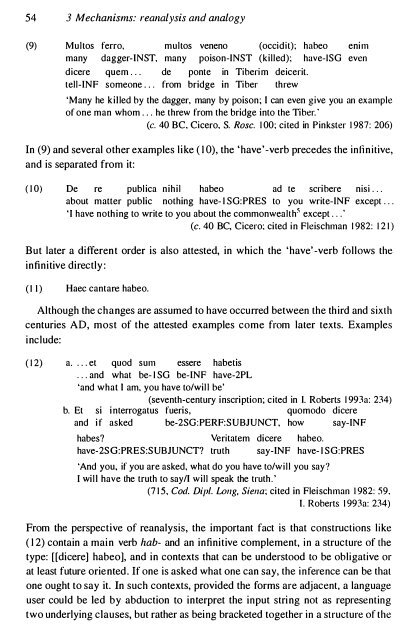Gram - SEAS
Gram - SEAS
Gram - SEAS
You also want an ePaper? Increase the reach of your titles
YUMPU automatically turns print PDFs into web optimized ePapers that Google loves.
54 3 Mechanisms: reanalysis and analogy<br />
(9) Multos ferro, multos veneno (occidit); habeo enim<br />
many dagger-INST, many poison-INST (killed); have-ISG even<br />
dicere quem . . . de ponte in Tiberim deicerit.<br />
tell-INF someone ... from bridge in Tiber threw<br />
'Many he killed by the dagger, many by poison; I can even give you an example<br />
of one man whom ... he threw from the bridge into the Tiber. '<br />
(c. 40 BC, Cicero, S. Rosc. 100; cited in Pinkster 1987: 206)<br />
In (9) and several other examples like (10), the 'have' -verb precedes the infinitive,<br />
and is separated from it:<br />
(10) De re publica nihil habeo ad te scribere nisi . . .<br />
about matter public nothing have- I SG:PRES to you write-INF except . ..<br />
'I have nothing to write to you about the commonwealth except . .. '<br />
(c. 40 BC, Cicero; cited in Fleischman 1982: 121)<br />
But later a different order is also attested, in which the 'have' -verb follows the<br />
infinitive directly:<br />
(I I) Haec cantare habeo.<br />
Although the changes are assumed to have occurred between the third and sixth<br />
centuries AD, most of the attested examples come from later texts. Examples<br />
include:<br />
(12) a . . .. et quod sum essere habetis<br />
... and what be- I SG be-INF have-2PL<br />
'and what 1 am, you have to/will be'<br />
(seventh-century inscription; cited in I. Roberts 1993a: 234)<br />
b. Et si interrogatus fueris, quomodo dicere<br />
and if asked be-2SG:PERF:SUBJUNCT, how say-INF<br />
habes? Veritatem dicere habeo.<br />
have-2SG:PRES:SUBJUNCT? truth say-INF have- I SG:PRES<br />
'And you, if you are asked, what do you have to/will you say?<br />
1 will have the truth to say/l will speak the truth.'<br />
(7 15, Cod. Dip/. Long. Siena; cited in Fleischman 1982: 59.<br />
I. Roberts 1993a: 234)<br />
From the perspective of reanalysis, the important fact is that constructions like<br />
(12) contain a main verb hab- and an infinitive complement, in a structure of the<br />
type: [[dicerel habeol, and in contexts that can be understood to be obligative or<br />
at least future oriented. If one is asked what one can say, the inference can be that<br />
one ought to say it. In such contexts, provided the forms are adjacent, a language<br />
user could be led by abduction to interpret the input string not as representing<br />
two underlying clauses, but rather as being bracketed together in a structure of the
















